Windows ink is a feature of Microsoft Windows 10 that lets you use a digital pen or your finger to draw or write on your PC. Obviously, this feature is only available on devices with touch-sensitive screens like a convertible laptop. This is quite a useful feature that is easy to use and handy especially for an art professional or a student.
Do you want to enable or disable Windows ink? Follow the below steps to learn some simple methods to do it.

Quick Overivew
Yes, it is perfectly safe to disable or enable Windows ink. Windows ink is a feature introduced by Microsoft in Windows 10 anniversary update in 2016. As it is an additional feature, it doesn’t matter whether you keep it on or turn it off. Also, enabling or disabling this feature will not affect your PC’s performance or functionality in any way.
Below are the methods to enable or disable it on your PC.
Methods to enable or disable Windows ink in Windows 10
Using local group policy editor (If you are using Windows 10 pro version)
If you are using Windows 10 pro, you should have the group policy editor application. This is the easiest method to disable windows ink in Windows 10.
1) Press Windows + R to open the Run Command
2) Type gpedit.msc in the text field and press ENTER
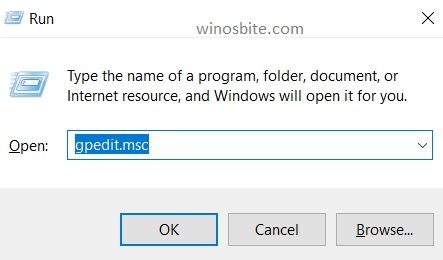
3) Navigate to the following directory in the left pane
- Computer Configuration ->Administrative Templates ->Windows Components ->Windows Ink Workspace
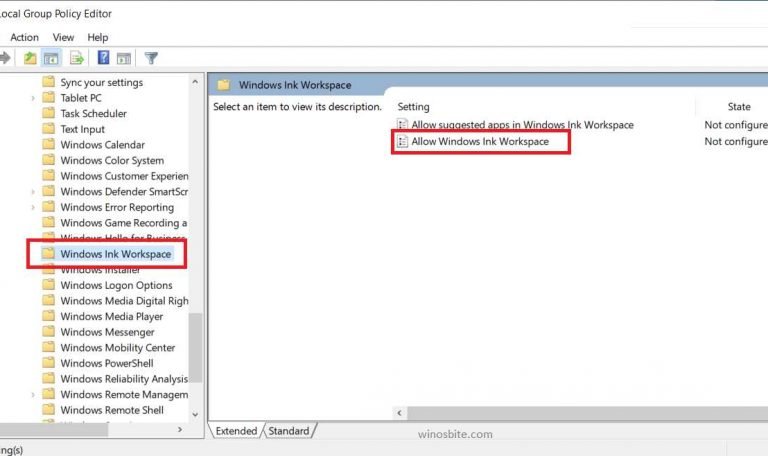
4) Now, in the right panel, open Allow Windows Ink Workspace
5) Select
- Enabled and ON if you want to enable it
- Disabled if you want to disable it

6) Apply the changes and exit the application.
If gpedit.msc is not present on your system, you might be using Windows 10 home instead of Windows 10 pro. Don’t worry, follow the method below to disable permanently or enable Windows ink on Windows 10 home.
Check how to disable gamebarpresencewriter on Windows 10 pc.
Using the Registry Editor
1) Press Windows + R to open the Run application
2) Type regedit in the text field and press ENTER to open the Registry editor

3) Go to the following location by entering the following directory in the text field at the top (or manually locate it)
- HKEY_LOCAL_MACHINE\SOFTWARE\Policies\Microsoft\WindowsInkWorkspace
If the WindowsInkWorkspace folder doesn’t exist, then right-click on Microsoft folder in the registry and create a new key by clicking on New->Key. Name the key as WindowsInkWorkspace.

4) Open the WindowsInkWorkspace key and right-click in the main panel -> New -> DWORD (32-bit) file and name it as AllowWindowsInkWorkspace (IGNORE THIS STEP IF AllowWindowsInkWorkspace WAS ALREADY PRESENT)

5) Double-click AllowWindowsInkWorkspace to open it and set its value data to 0 (for disabled) or 1 (for enabled), then click OK

6) Close the registry editor, then restart your PC.
Conclusion
That was it for the methods to enable or disable Windows ink feature on Microsoft Windows 10. In case of any queries or suggestions, don’t mind leaving a comment down below or contacting us.
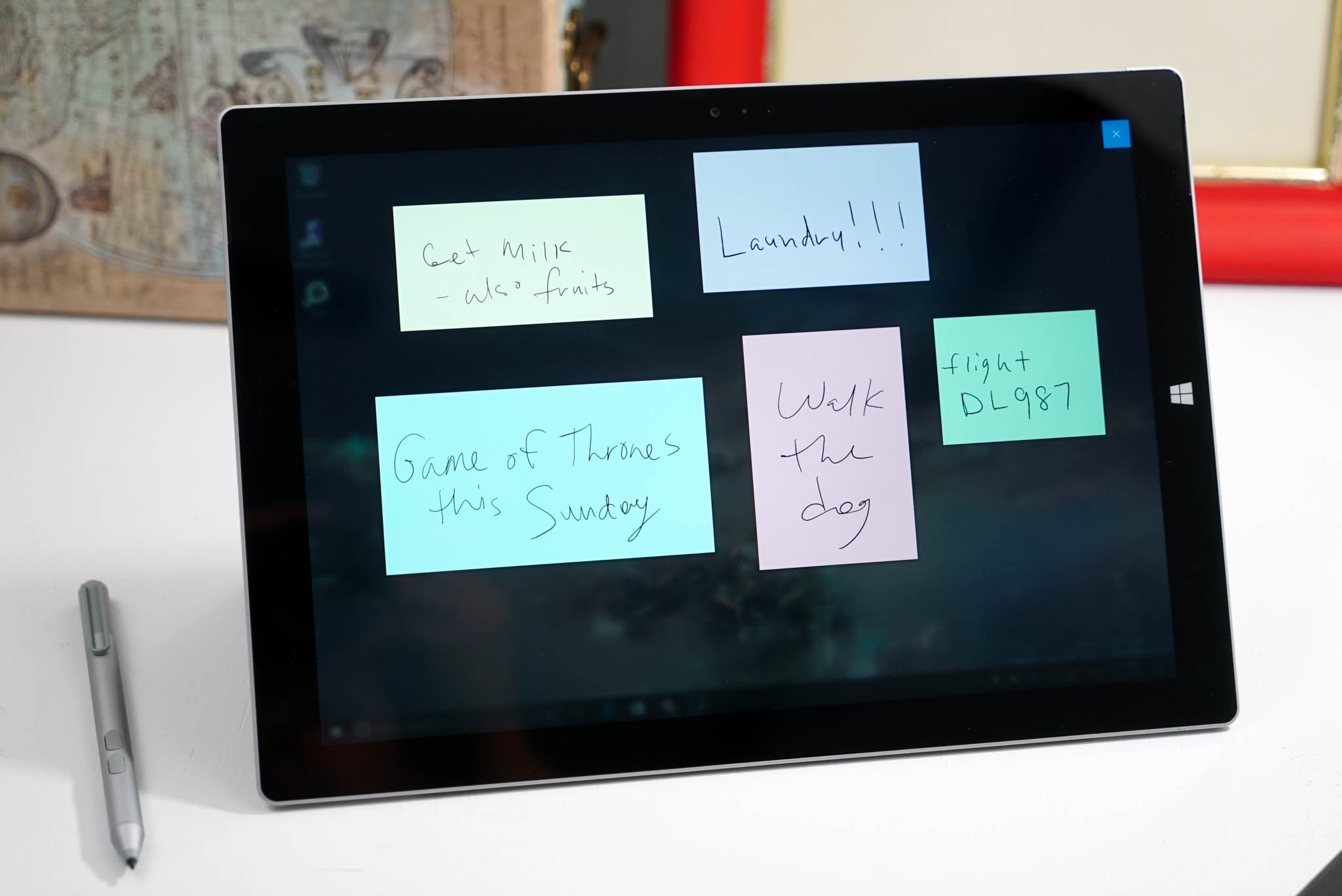
Windows Ink is a new pen experience that Microsoft is introducing with the Windows 10 Anniversary Update. At the core of Windows Ink, there is the same pen support that the operating system has included for years, but there are a number of new improvements.
It all starts with the Windows Ink Workspace that acts as the central hub to access the new Sticky Notes to create notes and reminders using Cortana, and you can also draw on a whiteboard or on a screenshot using Sketchpad or Screen sketch. In addition, Microsoft has promised to keep improving the experience to make it easier for developers to implement Windows Ink support on their apps.
If you own a Surface Book, Surface Pro 4, or similar device that includes support for an active pen, the Windows Ink experience will be enabled by default. However, as with any feature, the new improvements may not be for everyone, and this Windows 10 guide, we’ll walk you through the steps to disable Windows Ink Workspace completely from your device.
How to disable Windows Ink Workspace using Group Policy
There are multiple ways to disable Windows Ink Workspace, but the quickest way to completely turn off the experience is by using the Local Group Policy Editor — that’s of course if you’re using Windows 10 Pro, Enterprise, or Education.
- Use the Windows key + R keyboard shortcut to open the Run command.
- Type gpedit.msc and click OK.
- Select Computer Configuration.
- Expand the following path: Administrative Templates\Windows Components\Windows Ink Workspace.Note: It’s worth pointing out that if you see two «Windows Ink Workspace» entries, you must choose to configure the second one. Otherwise, the instructions will not work.
- On the right side, double-click the Allow Windows Ink Workspace setting.
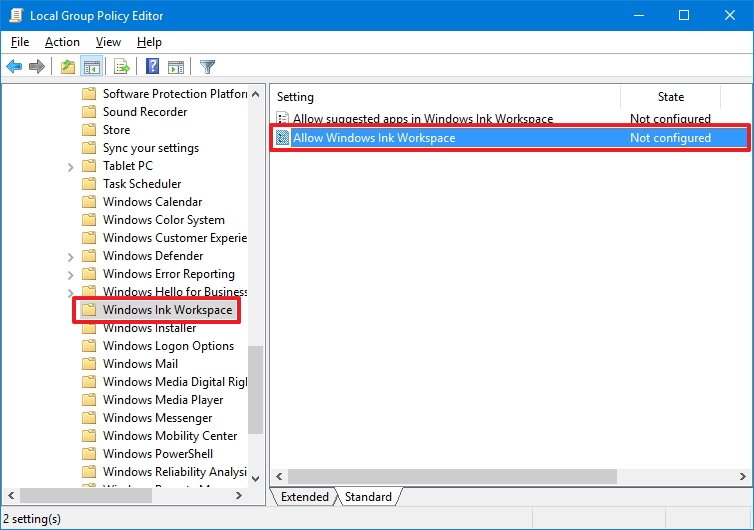
- Check the Enabled option.
- Under Options, select Disabled from the drop-down menu.
- Click Apply.
- Click OK.
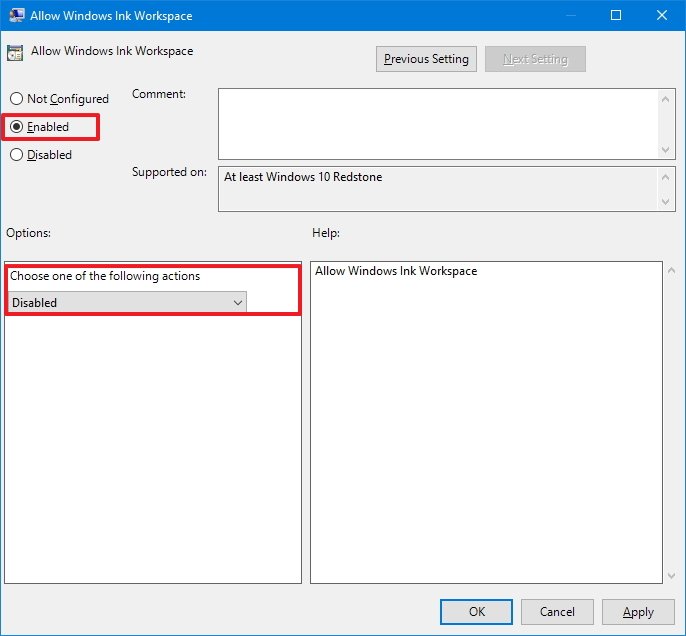
- Restart your computer to see the new changes.
Once you restart your device, the Windows Ink Workspace icon will no longer be available in the taskbar. And you’ll notice that the «Show Windows Ink Workspace button» option on the taskbar context menu will become unavailable.
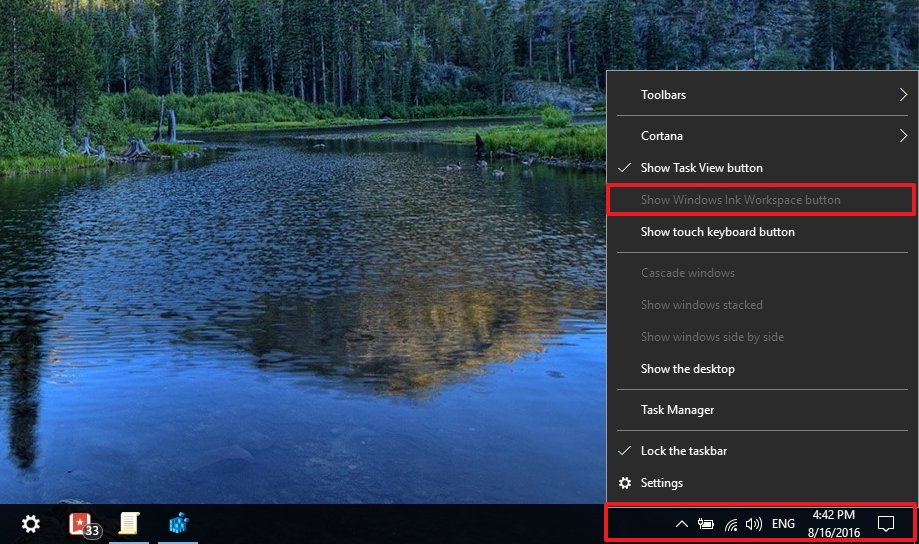
To revert the changes follow the steps mentioned above, but this time on step 8 select the Not Configured option instead.
How to disable Windows Ink Workspace using the registry
The Local Group Policy Editor is not a feature available on Windows 10 Home, but you can achieve the same results using the registry (if you’re up to the challenge).
All the latest news, reviews, and guides for Windows and Xbox diehards.
Important: Before you make any changes to the registry, make sure to understand that these changes may cause irreversible damage to your installation if they’re not done properly. It’s recommended that you do a full backup of your computer before proceeding. You’ve been warned!
- Use the Windows key + R keyboard shortcut to open the Run command.
- Type regedit, and click OK to open the Windows registry.
- Browse the following path:
HKEY_LOCAL_MACHINE\SOFTWARE\Policies\Microsoft\WindowsInkWorkspace - If you don’t see the WindowsInkWorkspace key (folder), then do the following:
- Right-click the Microsoft key, select New, and click Key.
- Name the new key WindowsInkWorkspace.
- Click OK.
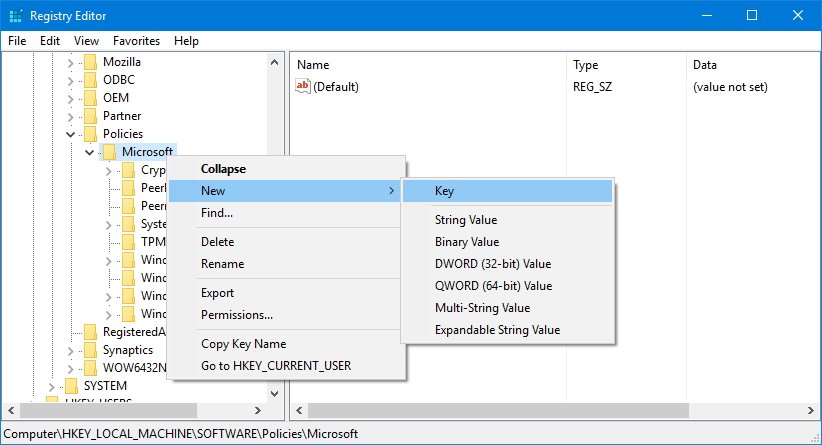
- Right-click on the right side, select New, and click DWORD (32-bit) Value.
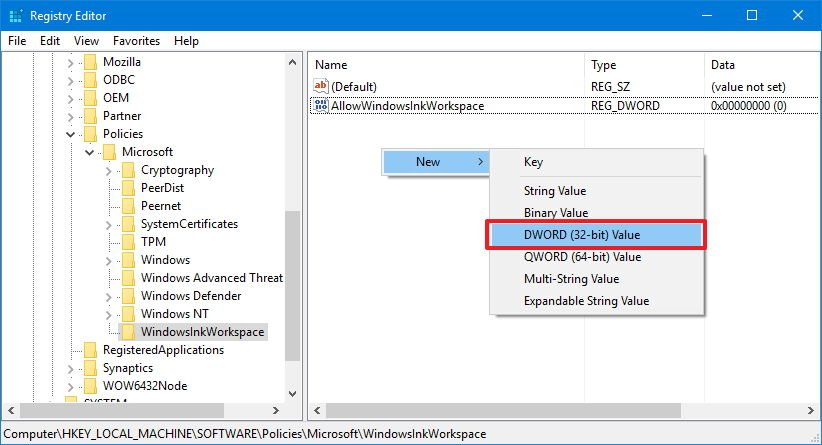
- Name the key AllowWindowsInkWorkspace.
- Click OK.
- Double-click the key and make sure its value is set to 0, which means disabled.
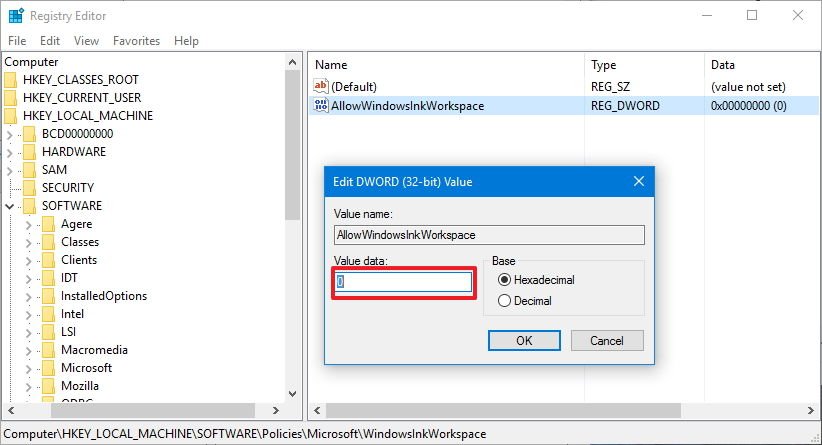
- Restart your computer to apply the changes.
Once you restart your device, identically as the process done with the Local Group Policy Editor, the Windows Ink Workspace icon will no longer be available in the taskbar. And you’ll notice that the «Show Windows Ink Workspace button» option on the taskbar context menu will become unavailable.

To enable Windows Ink Workspace again, simply follow the steps mentioned above and on step 9 make sure to change the value from 0 to 1, and restart your computer.
Wrapping things up
It’s important to note that after you’ve disabled Windows Ink Workspace, you won’t be able to launch Sketchpad or Screen sketch, but you’ll still be able to use Sticky Notes, as it’s a regular Windows Store app.
In addition, disabling the experience doesn’t remove the Pen & Windows Ink settings page from the Settings app. If you had the pen shortcuts configured to open Windows Ink Workspace, the pen button functions will fall back to open the OneNote app for all the options.
Do you use Windows Ink Workspace on the regular basis? Would you consider disabling the feature? Tell us in the comments below.
More Windows 10 resources
For more help articles, coverage, and answers on Windows 10, you can visit the following resources:
- Windows 10 on Windows Central – All you need to know
- Windows 10 Anniversary Update
- Windows 10 help, tips, and tricks
- Windows 10 forums on Windows Central
Mauro Huculak has been a Windows How-To Expert contributor for WindowsCentral.com for nearly a decade and has over 15 years of experience writing comprehensive guides. He also has an IT background and has achieved different professional certifications from Microsoft, Cisco, VMware, and CompTIA. He has been recognized as a Microsoft MVP for many years.
Quick Links
-
How to Open the Windows Ink Workspace
-
How to Launch and Find Pen-Enabled Apps
-
How to Use Sticky Notes, Sketchpad, and Screen Sketch
-
How to Configure Your Pen and Customize the Workspace
-
How to Disable the Windows Ink Workspace Icon
Windows 10’s Anniversary Update improves on Windows 10’s stylus support with a new «Windows Ink Workspace» feature. It’s designed to make using a digital pen faster and easier with a Windows 10 tablet or convertible device.
Aside from being a dedicated launcher for pen-enabled apps, the Windows Ink Workspace includes new Sticky Notes, Sketchpad, and Screen Sketch applications. You’ll also find more options for controlling how your pen functions in the Settings app.
How to Open the Windows Ink Workspace
To launch the workspace, click or tap the pen-shaped Windows Ink Workspace icon that appears in your notification area.
If you have a stylus or digital pen with a shortcut button, you can also quickly launch the Windows Ink Workspace by pressing the button on the pen. For example, if you have a Surface Pen, you can press the button on the pen to launch the workspace. That’s the default setting, at least—you can customize what the button does from the Settings app.
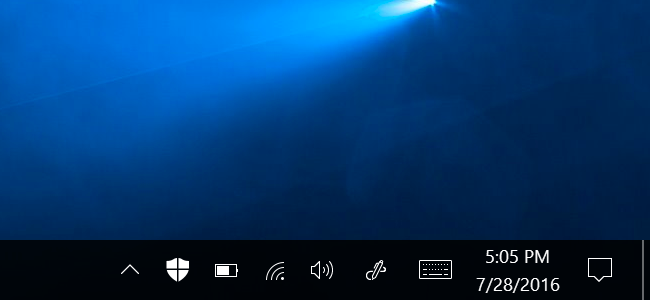
How to Launch and Find Pen-Enabled Apps
The Windows Ink Workspace is like a Start menu for getting stuff done with a pen. Rather than hunting down individual apps, you just grab your pen, press the button, and then tap the app you want to use with the pen.
It opens as a sidebar on the right side of your screen and provides quick access to apps like the new Sticky Notes, Sketchpad, and Screen Sketch tools, along with quick shortcut tiles to launch pen-enabled apps you recently used. These shortcut tiles are just another way to find and launch pen-enabled apps without your other installed applications getting in the way.
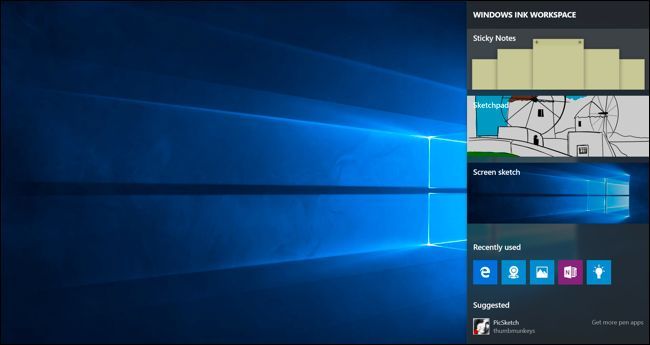
You’ll also see «Suggested» apps from the Windows Store here, and you can click or tap «Get more pen apps» to view a special page on the Windows Store that lists only pen-enabled apps. This gives you a faster way to find pen-enabled apps, like Microsoft’s own Fresh Paint application for digital art.
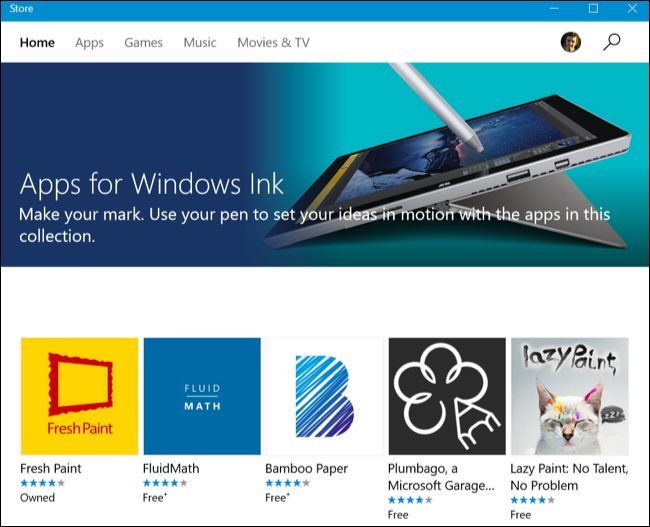
How to Use Sticky Notes, Sketchpad, and Screen Sketch
The three main Windows Ink Workspace apps are provided by Windows and designed to make using your pen easier and faster.
Use Sticky Notes to jot down notes with a pen (or just type them out with your keyboard) and refer to them later. Sticky Notes is a more lightweight app that’s ideal for quick notes. For more detailed, extensive note-taking, you’re probably better off with Microsoft’s OneNote.
When you open Sticky Notes, you’ll be asked if you want to «Enable insights», which will make Windows use character recognition read your sticky notes and use Bing and Cortana to provide more detailed information. For example, if you jot down a flight number, Sticky Notes will perform character recognition, recognize the flight number, and turn it into a link. Click or tap the link to view up-to-date details about that flight number. This is entirely optional, and the main purpose of the Sticky Notes app is just for writing notes with a pen or your keyboard.
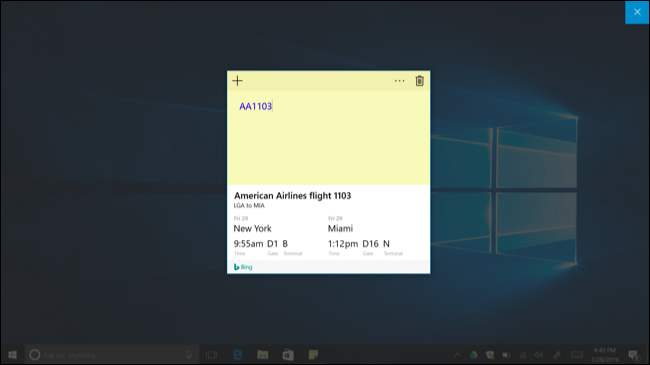
Sketchpad is basically just a digital whiteboard. You’ll find options for choosing different styles of writing, from thin pencil to colored pens and thicker highlighters of different colors. There’s also a virtual ruler you can enable that will allow you to draw a completely straight line. Place the ruler, draw, and your line will stay snapped to the edge of the ruler. You can save an image of your whiteboard to an image file or use the share button to send it to someone through another app.
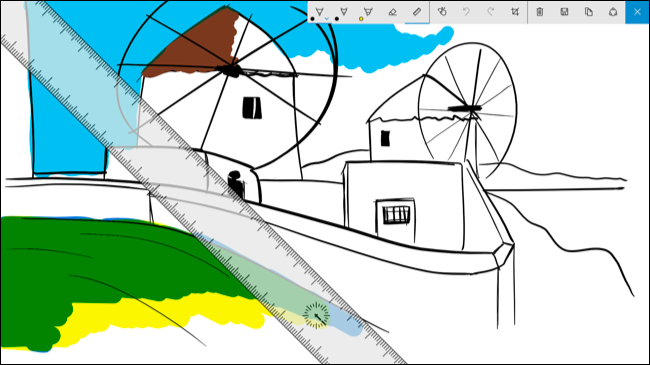
Screen Sketch is a fairly simple tool that allows you to mark up your screen. When you launch Screen Sketch, it will take a screenshot and give you drawing tools you can use to annotate it. Draw or write whatever you want over your screen, and then you can save the sketch to an image file and send it to someone or use the share button to share it with another app.
If you just want to save a screenshot without annotating it, use the Windows+PrintScreen keyboard shortcut instead.
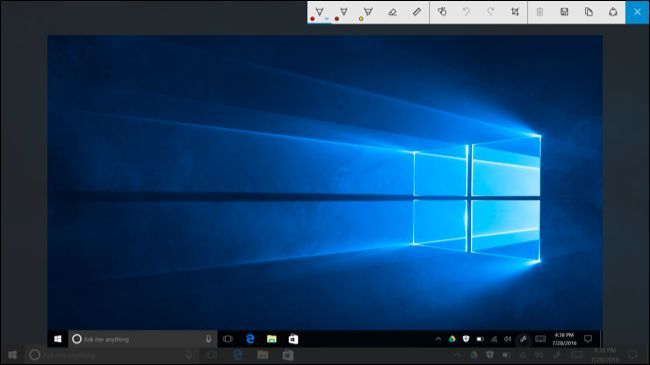
How to Configure Your Pen and Customize the Workspace
To customize the Windows Ink Workspace, head to Settings > Devices > Pen & Windows Ink. You’ll find a variety of options for controlling your pen and the Windows Ink Workspace here. For example, you can tell Windows whether you write with your right or left hand and choose what the button on the pen does when you click, double-click, or long-press it.
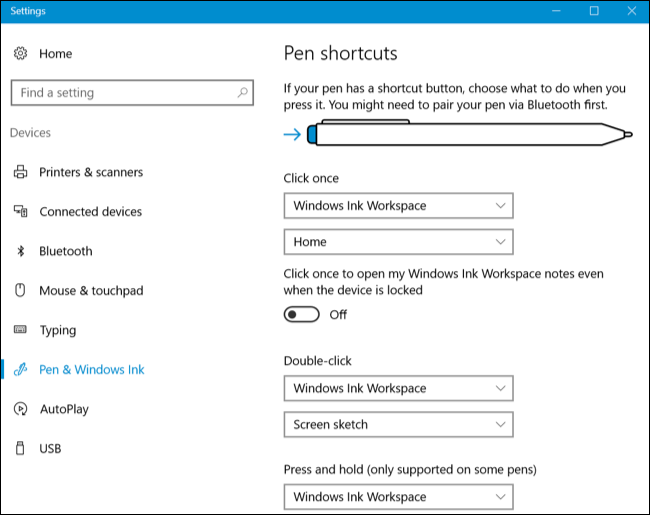
How to Disable the Windows Ink Workspace Icon
If you don’t plan on using a pen with Windows 10 and you want to get the Windows Ink Workspace off your taskbar, you can turn it off just like you’d turn off other system icons.
To do this, head to Settings > Personalization > Taskbar > Turn System Icons On or Off. Locate the Windows Ink Workspace icon here and set it to «Off».
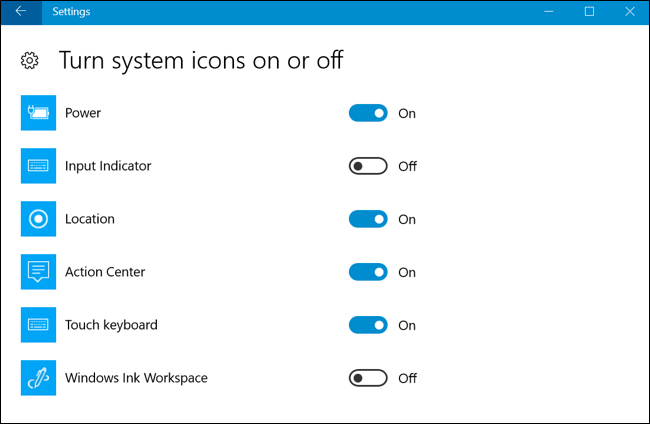
Do you wonder how to disable Windows Ink? Well, such knowledge would be handy for any Windows user. So, let’s go ahead and learn about this information.
Have you performed an update on your Windows OS lately? That means have you tried updating Windows to its 10th Anniversary Update? If that’s the case, you may occasionally notice a feature called Windows Ink Workspace.
Well, what does it mean? What does it do? Is it necessary to have it in your OS? Let’s find it out. Also, we will explain how to disable Windows Ink if you don’t need that feature.
An Introduction to Windows Ink Workspace
Before everything else, we should get substantial knowledge about Windows Ink Workspace and move forward. It is a new feature introduced to the 10th Anniversary Update.
You can notice that this feature is represented as a pen-shaped icon. The purpose of this feature is to improve the overall functionality of a digital pen.
In fact, the icon itself makes sense of what it represents. In simplest terms, thanks to this feature, you can use the digital pen with more flexibility and versatility. For instance, you can create sticky notes or draw on a whiteboard.
If not, you can even draw on a whiteboard. Also, it gives you the option of taking screenshots through Sketchpad.
How Can You Enable Windows Ink Workspace?
Well, in order to use this specific feature, you are supposed to click on the icon in the taskbar. That means the icon that appears in the form of a pen.
Customizing Your Windows Pen Experience
It is always possible to customize the pen in your Windows Settings. In order to get it done, you should go to the “Settings” option first and choose “Devices“. After that, you should go to the option called “Pen.”
Then, you will be able to see some quick actions performed for a single click or a double click. Also, the same feature allows you to configure the actions for the long press as well.

Well, needless to say, it features some good uses. However, there are some users who don’t want that feature. In other words, some individuals wonder how to disable Windows Ink in their OS due to some reason. If that’s the case with you, it is always possible to disable it with ease.
Well, if you wonder how to disable Windows Ink, you can read the following paragraphs and learn it. In fact, there are two specific methods to get it done, and we will explain them below.
PS: if you are experiencing the issues like Huion Pen not working, just read more.
Method 1: How to Disable Windows Ink Using Group Policy
Here’s the first method for those who wonder how to disable Windows Ink if you like it. In fact, this method doesn’t work on Windows 10 Home version. So, those who have their PCs running on Windows 10 Home should try the next method.
Mentioned below is how to disable Windows Ink using Group Policy.
- First of all, you should press the “Windows” and “R” keys on your keyboard simultaneously. This should be done in order to bring the “Run” window up. After that, you should enter the text “gpedit.msc” within the given field in the run utility. Then, you are supposed to hit the button labeled “OK” to proceed. If not, you can even hit the “Enter” key.
- Now, you will be directed to the Group Policy Window. After that, you are supposed to navigate to the path mentioned below.
“Computer Configuration -> Administrative Templates -> Windows Components -> Windows Ink Workspace“
Please check if you see two separate Ink Workspace entries. If yes, you will need to make the changes to the second option. Otherwise, you will not be able to disable the respective Windows Ink feature in your OS.
- Now, you can click on the option called “Allow Windows Ink Workspace” to proceed. That is located on the pane located on the right hand.

- Now, you are supposed to select the option called “Enabled“. Then, you should choose to go with “Disabled” located in the drop-down that appears. It is found under the option called “Options.” You can then click on the option called “Apply” and hit “OK” to complete the process.

- That’s basically it. To make those changes to be activated, you should perform a restart on the PC. As a result, you won’t find Windows Ink Workspace in the taskbar. So, that’s a pretty convenient process, isn’t it?
Method 2: How to Disable Windows Ink Using the Registry Editor in Your System
The second method is to make the changes with the assistance of the registry editor. That can eventually lead to various system errors that cannot be reversed. So, be sure that you follow the steps that are mentioned below with caution.
Also, it is imperative to create a backup of the important data on your PC before proceeding. Such an approach can be considered a safety measure because if something goes wrong, you can retrieve data.
Please Follow the Below Simple Guide to Use Registry Editor for This Purpose.
- As the first step, you are supposed to bring the “Run” utility up in your system. To get it done, you can press both the “Windows” and “R” keys at the same time. You should then enter the text “Regedit” in the given space. After that, you can either press “OK” or hit “Enter” to proceed.
- The above steps will bring a new window under the label “Registry Editor.” You can then navigate to the path mentioned below.
“HKEY_LOCAL_MACHINE\SOFTWARE\Policies\Microsoft\WindowsInkWorkspace”
Important: Can’t you find the folder labeled “WindowsInkWorkspace”? If that’s the case, you are supposed to create a new folder under the same name. Creating a new folder is a very simple process. You can easily perform right-click on the option called “Microsoft Key.” After that, you will see a new menu. Choose the option “New” in that respective menu. Then, choose “Key.” This key should be named “WindowsInkWorkspace.” After that, you are supposed to click on the button labeled “OK“.
- You can now create the key under the name “AllowWindowsInkWorkSpace.” You should follow the steps below to get it done. After that, you should go ahead and click on the key labeled “WindowsInkWorkspace” to expand it. Then, perform a right-click on an empty space that is located on the right-hand side. Now, you are supposed to select the option labeled “DWORD (32-bit) Value” to proceed. You should then name the key with “AllowWindowsInkWorkspace.” Then, you should set the value of that respective key to 0. Then, to complete the process, you should click on the button labeled “OK” to proceed.

- Now, you can save the changes made to the system by performing a reboot. You will now be able to receive the result that can be acquired through the previous method. As mentioned, this method is specifically helpful for those with Windows 10 Home version.
As mentioned before, we always recommend you create a backup of your important data before trying any repairs. Also, it is exceptionally important to back up your data on a regular basis as a general habit.
Such an approach will help you retrieve any important data upon a sudden system crash or any other error. You can even consider saving those backups in external drives as an extra precautionary method.
Frequently Asked Questions (FAQs)
Here are some frequently asked questions about disabling Windows Ink:
Can I re-enable Windows Ink after disabling it?
Yes, you can re-enable Windows Ink at any time by following the same steps outlined in this guide. Simply access the Windows Ink Settings and toggle on the “Use Windows Ink” option.
Will disabling Windows Ink affect other pen or touch features?
Disabling Windows Ink will only disable the Windows Ink Workspace and associated features. Other pen or touch features, such as basic stylus functionality, will not be affected.
Can I use a different stylus after disabling Windows Ink?
Yes, disabling Windows Ink does not restrict you from using a different stylus. You can still use other styluses or input devices without any issues.
Will disabling Windows Ink improve my device’s performance?
Disabling Windows Ink itself may not significantly impact your device’s performance. However, if you don’t use the Windows Ink Workspace or any of its features, disabling it can help declutter your system and potentially improve performance.
Are there any alternative applications to Windows Ink?
Yes, there are alternative applications available that offer similar functionality to Windows Ink. Some popular options include Adobe Photoshop, Sketchbook, and Bamboo Paper.
Is it recommended to disable Windows Ink?
Disabling Windows Ink is a personal preference. If you find that you don’t use the Windows Ink Workspace or its features, disabling it can streamline your user experience. However, if you frequently use Windows Ink for note-taking, drawing, or other tasks, it’s best to keep it enabled.
Final Words
Well, that’s all about how to disable Windows Ink. As you may notice, it requires only a little bit of effort to make those changes.
However, for any further questions related to this matter, we are always ready to help you. So, don’t hesitate to post a comment with your queries, and our experts will address them at their earliest.
Windows Ink, although an impressive feature, isn’t necessary for every user, and its random pop-ups can be frustrating for some. Users who regularly utilize it have reported issues such as brush lag, unresponsive or erratic movement, blank gray screens, and other interruptions in their workflow.

The random appearances of the workspace and other bugs are often due to a faulty or outdated digital touch device connected to the system. To use the workspace to its full potential, you should update or replace your device. However, if you choose to disable the Ink workspace, the following methods will guide you.
1. Disabling Ink Workspace via Regedit
You can disable the Ink Workspace by altering its policy’s value in the registry editor. Doing so will stop the ink service until you revert the value to its default setting.
Note: Exercise caution when working with the registry editor. Consider making a registry back before performing this method.
- Open the Windows search bar and type “Registry Editor”.
- Navigate to “HKEY_LOCAL_MACHINE”.
- Expand the dropdown and follow this path: HKEY_LOCAL_MACHINE > SOFTWARE > Policies > Microsoft > WindowsInkWorkspace.
- Locate the registry entry named “AllowWindowsInkWorkspace”, right-click on it, and then select Modify.
- In the prompt that appears, change the value to ‘0′.
If there is no existing registry for the Ink workspace:
- Right-click within the WindowsInkWorkspace key.
- Select New and then click DWORD (32-bit) Value to create a new registry entry.
- Name the new registry “AllowWindowsInkWorkspace” and set its value to ‘0’ as previously described.
2. Disabling Ink Workspace via Group Policy Editor
The Group Policy Editor allows you to modify the configuration of any running Windows service, such as the Ink Workspace, and to disable it on your computer.
Note: The Group Policy Editor is not typically needed by individual users, so it is disabled by default in the Windows 10 Home edition. If you want to install and use it, follow this guide.
- Type “gpedit.msc” into the search bar and open Edit Group Policy from the search results.
- Click to expand the Computer Configuration section, then navigate: Administrative Templates > Windows Components.
- Locate Windows Ink Workspace in the list.
- Access the setting named “Allow Windows Ink Workspace”.
- In the properties, select the Disabled option and then click OK.
3. Disabling Ink Workspace via the Services Tab
The Ink Workspace is a Microsoft service that can be enabled or disabled according to a user’s personal preference. The system configuration’s Services tab allows you to prevent the service from loading upon system startup.
- Type “msconfig” into the Windows search bar.
- Select “System Configuration” from the search results.
- Go to the “Services” tab from the menu bar.
- Uncheck “Touch Keyboard and Handwriting Panel Service” to disable it.
- Click “Apply” and then OK.
Kevin Arrows
Kevin Arrows is a highly experienced and knowledgeable technology specialist with over a decade of industry experience. He holds a Microsoft Certified Technology Specialist (MCTS) certification and has a deep passion for staying up-to-date on the latest tech developments. Kevin has written extensively on a wide range of tech-related topics, showcasing his expertise and knowledge in areas such as software development, cybersecurity, and cloud computing. His contributions to the tech field have been widely recognized and respected by his peers, and he is highly regarded for his ability to explain complex technical concepts in a clear and concise manner.











